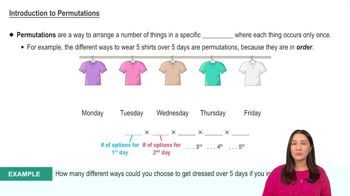Here are the essential concepts you must grasp in order to answer the question correctly.
Permutations
Permutations refer to the different ways in which a set of items can be arranged or ordered. In mathematics, the number of permutations of 'n' items taken 'r' at a time is calculated using the formula P(n, r) = n! / (n - r)!, where 'n!' denotes the factorial of 'n'. This concept is crucial for understanding how to count arrangements when the order of selection matters.
Recommended video:
Introduction to Permutations
Factorial
The factorial of a non-negative integer 'n', denoted as 'n!', is the product of all positive integers up to 'n'. For example, 5! = 5 × 4 × 3 × 2 × 1 = 120. Factorials are fundamental in permutations and combinations, as they provide the necessary counts of arrangements and selections in various mathematical contexts.
Recommended video:
Combination vs. Permutation
While both permutations and combinations deal with selecting items from a set, the key difference lies in the importance of order. Permutations consider the arrangement of items as significant, while combinations do not. Understanding this distinction is essential when determining which formula to apply in problems involving selections of items.
Recommended video:
Permutations vs. Combinations
 Verified step by step guidance
Verified step by step guidance Verified video answer for a similar problem:
Verified video answer for a similar problem:



 4:4m
4:4m